Yves GARY Hits: 9058
Category: RELIANCE
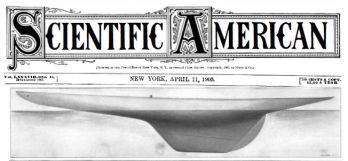 From the SCIENTIFIC AMERICAN - April 11, 1903
From the SCIENTIFIC AMERICAN - April 11, 1903At the close of the "America" cup races of 1901, when the results had proved that the two yachts had come so closely together that the result was largely a question of the accidents of seamanship and weather, it was acknowledged on all hands that their designers had apparently reached the limit of their skill ...
... with the type of yacht employed for these contests. Herreshoff, in spite of all the rich store of knowledge acquired in the construction of four previous cup defenders, had been unable in that year to produce a boat superior to his own "Columbia"; while Watson, in spite of the much-talked-of tank experiments, was unable to beat "Shamrock I" in her improved condition, by more than a very small margin.
When the challenge for this year's series of contests was received and accepted, the necessity of building a new cup defender was apparent. The supposed superiority of "Constitution" to "Columbia" was at best very hypothetical, and based solely upon the presumably better handling that "Columbia" had received during the trial races. At the same time, in view of the fact that Fife, whose "Shamrock I" after some readjustment of her sail plan, had proved to be practically equal under many conditions of sailing to "Shamrock II", had been commissioned to build the new boat, and that in all probability he would succeed in turning out a craft that was faster than either of the two "Shamrocks," it was realized that to insure the retention of the cup a new defender should be built, and that the task of designing and constructing the craft should be given to Herreshoff.
This much decided upon, there arose the important question as to what kind of yacht should be built, a question more easily asked than answered. Indeed, "Columbia" had proved such an extremely satisfactory boat, that when it came to the question of the design of "Constitution," Herreshoff made no further change in model than to increase the beam by one foot and enlarge the sail plan to match the greater power of hull thus secured. In construction "Constitution" had some advantages of lightness and strength due to the system of belt-and-longitudinal framing adopted; and it was a source of great surprise and general disappointment that with her greater power, greater sail spread, and general lowering of weights of hull, she did not show any decided superiority to the older boat. It looked as though Herreshoff had done what Watson had frankly declared that he had himself done, namely, exhausted his resources in the development of the conventional type of 90-foot racing yacht. 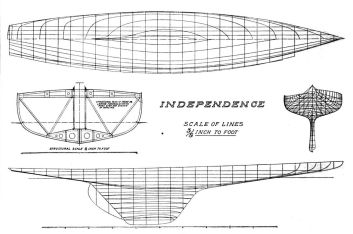 There was no further gain to be looked for in the direction of reduction of weights, nor, judging from the results in "Constitution," was there any advantage in increase of power by increase of displacement and sail area, not, at least, if the same typical midship section was to be retained. If any radical departure was to be taken, experience in smaller classes of yachts had shown that it must be in the direction of the broad, shoal-bodied craft of the modified scow type, a type which had proved to be practically invincible in these classes. Now, Herreshoff has never in his larger boats appeared desirous of going very far in this direction.
There was no further gain to be looked for in the direction of reduction of weights, nor, judging from the results in "Constitution," was there any advantage in increase of power by increase of displacement and sail area, not, at least, if the same typical midship section was to be retained. If any radical departure was to be taken, experience in smaller classes of yachts had shown that it must be in the direction of the broad, shoal-bodied craft of the modified scow type, a type which had proved to be practically invincible in these classes. Now, Herreshoff has never in his larger boats appeared desirous of going very far in this direction.
At the same time, there is no denying the fact that the bold departure made by the young Boston designer, Crowninshield, when he produced the scow-fin 90-footer "Independence," while it did not achieve the object aimed at of producing the all-round fastest cup yacht of that year or any year, nevertheless served to give some most valuable data and proved to a demonstration that on certain points of sailing, a properly designed 90-foot modified scow was faster than anything afloat. Although "Independence" showed all the faults of the scow type when going to windward, pounding heavily in a breeze and head sea, and spilling the wind out of her sails under the conditions of a sea and a light breeze after the manner of all beamy shallow craft, she had proved that on a broad reach she was the fastest 90-foot sloop ever constructed.
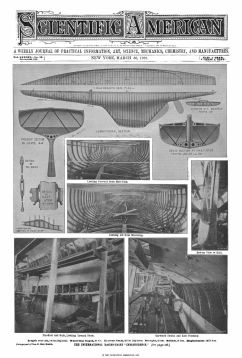 On a certain memorable day off Newport, in a breeze of from 17 to 25 knots strength, although, as was to be expected, she was beaten by "Columbia" on the windward leg, she overhauled that boat (herself remarkable for her reaching qualities) at a pace which gave reason to believe that were "Independence" properly tuned up, she would, with all her faults to windward, have proved more than the master of "Columbia" or "Constitution" on a triangular course in a wind of any strength. Her performance in reaching made a profound impression upon the amateur element among those who are intimately connected with the defense of the cup ; an impression so strong that when the cup yacht was ordered, it was made a sine qua non that she should embody some of the best features of the "Independence" type. And right here, it is but just to Mr. Crowninshield to acknowledge the most important contribution he has made to the defense of the "America" cup ; for it was pretty safe to say that had "Independence" not been built, the defense of the cup this year would never have been entrusted to a vessel of the extreme type which is now being built at the Herreshoff yards.
On a certain memorable day off Newport, in a breeze of from 17 to 25 knots strength, although, as was to be expected, she was beaten by "Columbia" on the windward leg, she overhauled that boat (herself remarkable for her reaching qualities) at a pace which gave reason to believe that were "Independence" properly tuned up, she would, with all her faults to windward, have proved more than the master of "Columbia" or "Constitution" on a triangular course in a wind of any strength. Her performance in reaching made a profound impression upon the amateur element among those who are intimately connected with the defense of the cup ; an impression so strong that when the cup yacht was ordered, it was made a sine qua non that she should embody some of the best features of the "Independence" type. And right here, it is but just to Mr. Crowninshield to acknowledge the most important contribution he has made to the defense of the "America" cup ; for it was pretty safe to say that had "Independence" not been built, the defense of the cup this year would never have been entrusted to a vessel of the extreme type which is now being built at the Herreshoff yards.
The problem, then, before the Bristol designer was to produce a yacht with all the best features of the scow type, such as great sailing length when heeled, and large sail-carrying power, with as few as possible of the scow's drawbacks, such as the flat floor forward and the hard shoulders which helped so greatly to the undoing of " Independence" in a troubled sea. And this Herreshoff has achieved, if we may judge from the model of "Reliance;" although with what measure of success will never be known until the boat commences to toy on some calm day with the left-over disturbance of a yesterday's blow. The new boat has more beam and considerably less dead rise than "Constitution," a harder bilge and longer ends, particularly in the forward overhang.
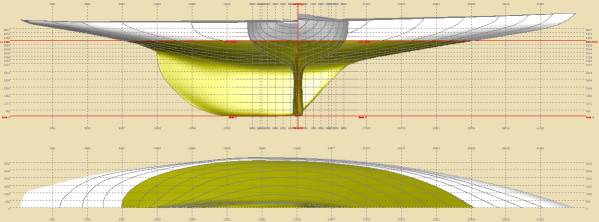 Her extreme beam is 25 feet 8 inches; her draft, 18 feet 9 inches; and her length over all, 140 feet. In her midship section she shows exactly 2 feet less dead rise than "Constitution," and while her hull is not so shallow as that of "Independence," it is still sufficiently shallow to allow the ends to be carried out to give practically the same length on deck as the Crowninshield boat. While she will thus secure something of the same long, flat floor, she differs from "Independence" in the fact that the fullness of her bilges, as shown in the midship section, is not carried out into the forward overhang, as was done in the Boston boat, the sections from the water-line at the stem to the bow being something of a compromise between the almost semi-circular sections at the waterline of "Shamrock II" and the decided V-sections of "Columbia" and “Constitution."
Her extreme beam is 25 feet 8 inches; her draft, 18 feet 9 inches; and her length over all, 140 feet. In her midship section she shows exactly 2 feet less dead rise than "Constitution," and while her hull is not so shallow as that of "Independence," it is still sufficiently shallow to allow the ends to be carried out to give practically the same length on deck as the Crowninshield boat. While she will thus secure something of the same long, flat floor, she differs from "Independence" in the fact that the fullness of her bilges, as shown in the midship section, is not carried out into the forward overhang, as was done in the Boston boat, the sections from the water-line at the stem to the bow being something of a compromise between the almost semi-circular sections at the waterline of "Shamrock II" and the decided V-sections of "Columbia" and “Constitution."
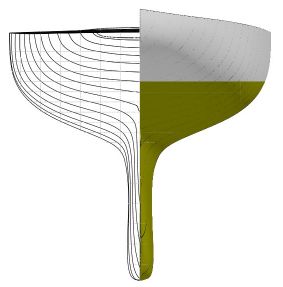 While there is some loss of power in this modification, there will be a decided gain in easiness in a seaway, especially when the seas are short; and while the new boat will pound somewhat heavily under these conditions, she is not likely to take the bit in her teeth, as did "Independence" and run wild under a freshening breeze or in sudden puffs. Although the draft is less than that of "Constitution," the keel is longer and the bulb is drawn out to finer lines. The mast relatively to the load-water line, is stepped in the same position as in "Constitution," and with her 100 tons of lead in the keel, her harder bilges, greater beam, and greater length of waterline when heeled, she will naturally possess larger sail-carrying power; she will spread in the neighborhood of 15,000 square feet of canvas.
While there is some loss of power in this modification, there will be a decided gain in easiness in a seaway, especially when the seas are short; and while the new boat will pound somewhat heavily under these conditions, she is not likely to take the bit in her teeth, as did "Independence" and run wild under a freshening breeze or in sudden puffs. Although the draft is less than that of "Constitution," the keel is longer and the bulb is drawn out to finer lines. The mast relatively to the load-water line, is stepped in the same position as in "Constitution," and with her 100 tons of lead in the keel, her harder bilges, greater beam, and greater length of waterline when heeled, she will naturally possess larger sail-carrying power; she will spread in the neighborhood of 15,000 square feet of canvas.
It is a curious fact that, broadly speaking, the English designers are working on opposite lines from those outlined above. The new Fife boat, as compared with the two "Shamrocks," will have a deeper body, considerably more dead rise, greater fullness in the garboards, and somewhat less overall length, the model thus reverting somewhat to the type of "Valkyrie II" and "Britannia". Hence, for the second time in the history of these cup races, the American and British designers have crossed each other, our boat running to great beam, shoalness of body, and large wetted surface and the English craft tending to greater fullness of body, large displacement, and a small wetted surface. Should both boats come up to the designers' expectations and prove to be a success, the outcome of the races will depend, more than it has for several years past, upon the conditions of wind and weather. In light breezes and troubled water the advantage should lie with "Shamrock III." Also when "split open," that is running dead before the wind, with spinnaker set, the larger displacement and finer-lined Fife boat, with her smaller wetted surface, should prove to be the faster both in light winds and strong.
On the other hand, on a triangular course, where there is much reaching to be done, especially under the conditions of a strong breeze and a smooth sea, "Shamrock III" should be hopelessly beaten, while in a rough sea and strong wind, and under any conditions where reefing becomes necessary, the advantage, except in reaching, 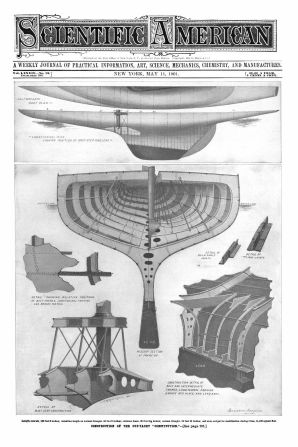 should lie with the Fife boat. Seeing, however, that moderate winds and fairly smooth seas prevail during August, it would look as though the extreme boat which Herreshoff is building should prove to be the winner.
should lie with the Fife boat. Seeing, however, that moderate winds and fairly smooth seas prevail during August, it would look as though the extreme boat which Herreshoff is building should prove to be the winner.
The belt-and-longitudinal framing that Herreshoff used in "Constitution" proved to be so successful that it has been adopted practically without any change In the new boat. This system was elaborately described and illustrated in the SClENTIFIC AMERICAN of May 11, 1901, and the reader is referred to that article for the details of construction. Broadly speaking, the framing of "Reliance" consists of nickel-steel belt frames of deep section, which are spaced 6 feet 8 inches apart, the frames occurring at every fourth station of the eighty-four stations which make up the full overall length of the yacht. These frames extend entirely around the interior of the yacht, and embody the floor plates, frames, and deck beams in one. They are deepest where they form the floor plates, and they become shallower as they run up through the bilges to the deck beams. The hull plating which is of Tobin bronze and nickel-steel is laid on in seven strakes with flush joints ; the first six strakes are of bronze and the seventh or sheer strake is of nickel-steel.
In addition to the belt-framing there is a series of longitudinal frames consisting of alternating T-irons and bulb angles. The T-irons are laid along the seams to which they are riveted, while the bulb angles extend longitudinally midway between the seams, and serve to give additional stiffness to the plating and to reinforce the longitudinal strength of the boat. To prevent the buckling of the belt-frames, a series of plate-steel knees are worked in between the frames and the T-irons, the knees being placed on opposite sides of the belt frames, that is, one series of knees being on the left side of the frame on one T-iron, and on the right side of the frame on the next T-iron.
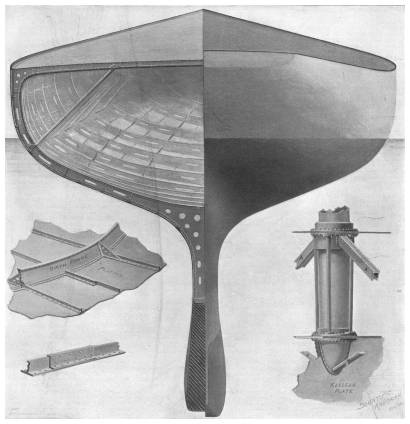 In a vessel of the great deck area of "Reliance," especial attention must be paid to the question of lateral stiffness; and this is provided by a system of diagonal strapping consisting of 5-16 nickel steel straps, covering the whole area of the deck. These straps are securely riveted to each other where they intersect, and at the partners where the mast passes through the deck there is worked in a diamond-shaped plate of steel ⅜ of an inch thick and measuring 4 feet on the side, which is riveted to the strapping and serves to hold the heavy collars which form the mast partners. Over the strapping thus formed is laid a continuous deck of aluminum plating.
In a vessel of the great deck area of "Reliance," especial attention must be paid to the question of lateral stiffness; and this is provided by a system of diagonal strapping consisting of 5-16 nickel steel straps, covering the whole area of the deck. These straps are securely riveted to each other where they intersect, and at the partners where the mast passes through the deck there is worked in a diamond-shaped plate of steel ⅜ of an inch thick and measuring 4 feet on the side, which is riveted to the strapping and serves to hold the heavy collars which form the mast partners. Over the strapping thus formed is laid a continuous deck of aluminum plating.
The mast-step will be of the same general construction as that of “Constitution." It is formed by deepening the keelson to a depth of 4½ feet, by adding an additional belt-frame and by considerably deepening the foot-plate portion of these frames in the wake of the mast. At the partners there will be two heavy collars, one above and one below the steel deck plate, the upper one being formed of a 6 x 6 inch angle iron, 1 inch in thickness, and the lower of a 6 x 12 inch angle iron also 1 inch in thickness. The 6-inch flanges of these collars will be riveted to the steel deck plate by rivets which pass entirely through from collar to collar. Four heavy, vertical ties also extend from the deck to the top of the mast step where they take hold of the collar which forms the actual footing for the mast. The construction at the mast is also greatly stiffened by a pair of heavy struts of box section, which extend from the mast partners to the bilges. It will be noticed that the construction is in general very similar to that of "Constitution;" whose hull was so stiff that when the vessel was close-hauled it was impossible to tell by the bulkhead doors upon which tack the yacht was sailing.

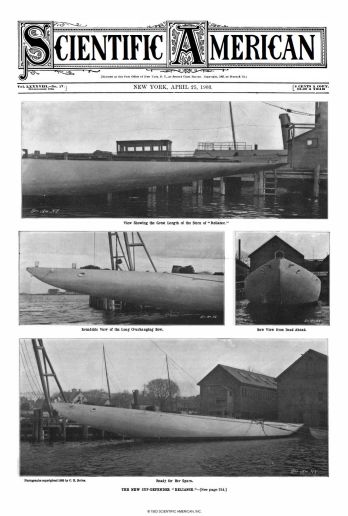 From the SCIENTIFIC AMERICAN - April 25, 1903
From the SCIENTIFIC AMERICAN - April 25, 1903Contemporaneously with the publication of our special Yachting and Automobile number, the new cup defender "Reliance" was having her first taste of salt water, and the new challenger "Shamrock III" was engaged in one of her most successful trials against "Shamrock I". In the issue referred to, we so fully described the design and construction of "Reliance," that it is not necessary to do much more now than point out how completely the photographs of the boat which we herewith publish agree with that account of the yacht.
The events of the yachting seasons of 1901 and 1902, and the performance of certain very successful racing craft in those two years, notably the cup yacht "Independence," and the sister boats "Neola" and "Weetamoe," which more than saved their time on the Herreshoff 70-footers last year, rendered it pretty certain in the judgment of the yachting "sharps" that, when the folding doors of the Herreshoff building shed were opened, there would pass out through them a vessel of very extreme type.
Consequently the exaggerated proportions of the forward and after overhangs of the new boat, as shown in our illustrations, caused no surprise, even though they are the work of such cautious and conservative builders as the Bristol firm.
In view of the rather demonstrative merriment which greeted the appearance of "Independence," with her hard turned bilges, her blunt forward and after waterline, and her huge overhangs, each some 25 feet in length, it must have been something of a shock to the critics to witness, sliding down the ways on which the wholesome models of "Columbia" and "Constitution" made their first bow to the public, a boat which so far out-Heroded Herod, that her overhangs divide up nearly 60 feet of the overall length of the yacht between them.
At the same time it must be admitted that, with all her exaggerated proportions, the boat bears a strong family likeness to the modern Herreshoff boats; and there is no denying that in drawing out her lines to such extreme length, Herreshoff has produced an extremely handsome craft. 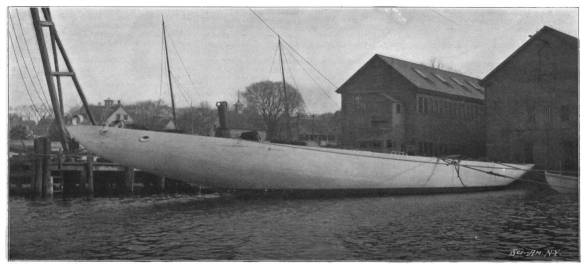 As we explained in our previous issue, the hard turn of the midship sections at the bilges is softened out gradually as the forward and after ends of the waterline are reached, with the result that the overhangs themselves are very symmetrical and show a sweetness of modeling which goes far to redeem their disproportionate length. The deck-line does not flow toward the bow and stern with so flat a curve as has been customary in earlier Herreshoff boats, with the result that when the yacht is heeled, she will take a very long bearing, and there will be no hard spot or shoulder to pile up the water when the vessel is driven at high speed-as happened in the case of "Shamrock II" and even more noticeably in "Independence."
As we explained in our previous issue, the hard turn of the midship sections at the bilges is softened out gradually as the forward and after ends of the waterline are reached, with the result that the overhangs themselves are very symmetrical and show a sweetness of modeling which goes far to redeem their disproportionate length. The deck-line does not flow toward the bow and stern with so flat a curve as has been customary in earlier Herreshoff boats, with the result that when the yacht is heeled, she will take a very long bearing, and there will be no hard spot or shoulder to pile up the water when the vessel is driven at high speed-as happened in the case of "Shamrock II" and even more noticeably in "Independence."
The great beam of "Reliance," and the fact that her waterline is full, proves that her wetted surface will be very large ; and while the small deadrise and long flat floor will give her great initial stability, they will render it somewhat difficult to get her to heel to her sailing lines in light winds. These characteristics combined will render her relatively less speedy in light weather, particularly if there is a troubled cross sea running. But with every added pound in the pressure of the wind, and every added angle of heel, the boat, to our thinking, will show great increase in speed, and even in spite of the excellent work which is being done by "Shamrock III" on the other side, she should prove to be the fastest 90-footer afloat.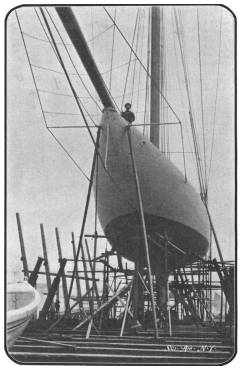
One of the most striking features in the boat is the long drawn-out bow which projects nearly thirty feet beyond the waterline. Only a small proportion of it can be utilized for gaining sailing length; for "Independence" at thirty degrees heel only added five feet of length forward, and she was even flatter than "Reliance." Driving into a head sea, she will take the seas a little earlier but not so much earlier as to compensate, one would think, for the carrying of so much added bow weight at a height of eight or nine feet above the water. Many yachtsmen will wonder why the bow was not made shorter relatively to the stern ; for in a low, long stern such as that of "Reliance," every foot of length can be utilized. "Reliance," however, is regarded even by her designer as something of an experiment, and only the actual test in a jump of a sea off Newport or Sandy Hook can determine the value of such an extreme bow.
When the new craft was fairly afloat, it looked as though she might sit a little low in the water when her spars, sails, anchor, crew, etc., which will weigh about 19¼ tons, were put aboard; and although her full waterlines give her great buoyancy, it is not probable that much, if anything, can be gained by a shortened waterline when she comes to be measured.
Unquestionably the new cup defender is the most interesting 90-foot racing yacht that Herreshoff has built. She is certain to be fast, and under certain conditions extremely fast. Judged on her lines, power, and huge sail plan, she should beat "Shamrock III" but the latter boat, up to the hour of her disaster, was certainly doing wonderful work against "Shamrock I" herself a greatly improved boat.

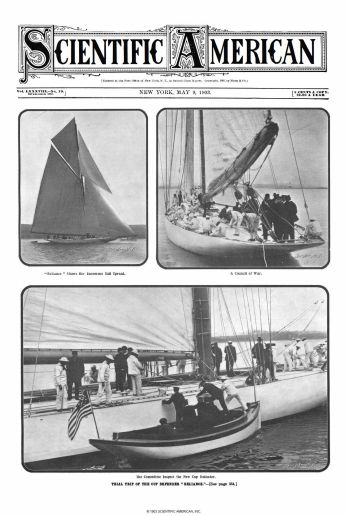 From the SCIENTIFIC AMERICAN - May 30, 1903
From the SCIENTIFIC AMERICAN - May 30, 1903Surely in all the long history of trial races, whether between cup defenders in America, or between cup challengers in their try-outs in British waters, there was never a race sailed that provided such sensational results as were achieved by the new yacht "Reliance" in her first trial race on Long Island Sound.
In the first place, none of the American defenders has come to the line with so little actually known as to her sailing capabilities. Because of keen rivalry between the three contestants for cup-defending honors this year, neither "Constitution" nor "Columbia" has been willing to give "Reliance" any opportunities for those preliminary "brushes" and trying-out "spins" on the various points of sailing, which from time immemorial have been granted as a matter of courtesy by former champions to a new aspirant for cup-defending honors. Hence "Reliance" has been doing all her tuning up in very solitary fashion; and, although to those in charge of her she appeared to be thoroughly satisfactory, balancing well, carrying a light helm, and apparently showing great speed under all conditions of sailing, neither her owners nor captain knew exactly what her abilities were, as she drew near the starting line on Thursday last,. and commenced to maneuver for position with that well-tested veteran "Columbia." Because of an accident when being hauled out upon the ways, "Constitution" took no part in the race, being at the time in the shipbuilder's hands for the straightening out of some plates that were slightly indented.
The race was sailed in a perfectly smooth sea and a breeze that varied from a knot or two per hour to a maximum strength of about eight or ten; and, therefore, the conditions were the very best possible for a boat with the broad and shoal body and great sail spread of "Reliance." The course consisted of an 11-knot leg down the Long Island shore with the wind over the starboard quarter; a 3-mile reach across the Sound with the wind over the port quarter; and a beat of 11 miles for home. The greatest surprise of the day was furnished on the first leg, when, with a wind that averaged about 3 knots in strength and never exceeded 6 or 7 knots, "Reliance" drew away very rapidly from "Columbia," gaining at an average rate of 40 seconds per mile. It was supposed that in spite of her much larger sail spread ("Columbia" having 13,200 square feet, and "Constitution" nearly 16,000), the greater weight and larger wetted surface of 'Reliance" would cause her to show about the same drifting qualities as the smaller boat; but as it was, she beat "Columbia" about as badly as "Constitution" used to beat her two years ago under like weather conditions.
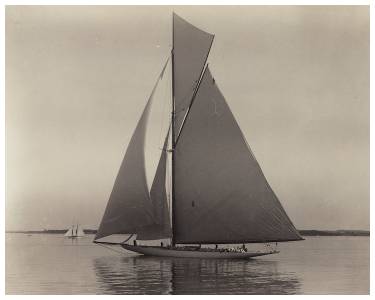 After gibing round the first mark, "Reliance" heeled down to a freshening breeze until her lee rail was well under, and proceeded to show something of the well-known reaching ability o f the scow type. Her water-line lengthened some 5 or 6 feet forward and drew out for fully 25 feet under the long counter; and considering that the yacht for the first mile of the 3-mile leg must have been going fully 14 to 14½ knots an hour, she made remarkably little disturbance of the water. There was no perceptible drag, and the bow and stern waves were extremely light for a boat of that size moving at such high speed. On this leg she beat "Columbia" 1 minute and 30 seconds, or at the rate of half a minute a mile. It is possible that some time may have been lost by "Columbia" because of the fact that while "Reliance" carried her jib in addition to her balloon-jib topsail and staysail, the older boat did not use her jib over a considerable part of the distance; but even if allowance be made for this fact, the performance of the new boat was most remarkable.
After gibing round the first mark, "Reliance" heeled down to a freshening breeze until her lee rail was well under, and proceeded to show something of the well-known reaching ability o f the scow type. Her water-line lengthened some 5 or 6 feet forward and drew out for fully 25 feet under the long counter; and considering that the yacht for the first mile of the 3-mile leg must have been going fully 14 to 14½ knots an hour, she made remarkably little disturbance of the water. There was no perceptible drag, and the bow and stern waves were extremely light for a boat of that size moving at such high speed. On this leg she beat "Columbia" 1 minute and 30 seconds, or at the rate of half a minute a mile. It is possible that some time may have been lost by "Columbia" because of the fact that while "Reliance" carried her jib in addition to her balloon-jib topsail and staysail, the older boat did not use her jib over a considerable part of the distance; but even if allowance be made for this fact, the performance of the new boat was most remarkable.
It was expected that when sheets were flattened in for the final thrash to windward, the great ability of "Columbia" on this point of sailing would show itself, and that she would at least hold the big boat, if she did not cut down some of her lead; but, again to the surprise of the yachting "sharps," "Reliance" continued to pull away from her now badly-beaten competitor, and on the 11-mile beat she gained 4 minutes and 23 seconds, which is equal to a gain of about 24 seconds per mile, the speed of "Reliance" being a trifle over 10 knots per hour. In the broad reach over the 3-mile leg of the course "Reliance" averaged 13.2 knots per hour; and it is certain that if the breeze had held at the strength which it had on the first mile of this leg, the new yacht would have shown a considerably higher average speed than that.
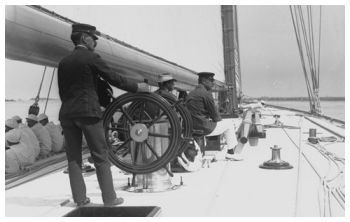 We have said that the race was sailed under ideal conditions for a boat of the "Reliance" type, and in all probability she will not be able to pull away from "Columbia" in anything like such an impressive manner when there is a sea running, or when the race has to be sailed under shortened canvas; while the most disadvantageous conditions possible would be the combination of a lumpy sea and a 'light breeze. As there are yet some dozen or more races to be sailed between the two cup yachts, some of them to take place off Newport and over the cup course off Sandy Hook, this doubt is certain to be satisfactorily settled long before "Reliance" meets "Shamrock III." in an international race.
We have said that the race was sailed under ideal conditions for a boat of the "Reliance" type, and in all probability she will not be able to pull away from "Columbia" in anything like such an impressive manner when there is a sea running, or when the race has to be sailed under shortened canvas; while the most disadvantageous conditions possible would be the combination of a lumpy sea and a 'light breeze. As there are yet some dozen or more races to be sailed between the two cup yachts, some of them to take place off Newport and over the cup course off Sandy Hook, this doubt is certain to be satisfactorily settled long before "Reliance" meets "Shamrock III." in an international race.
The accompanying views of the "Reliance" were taken when she was hauled out to clean the underbody for this race. The most surprising feature was the extreme breadth and shoalness of the forebody, the yacht showing up extremely shallow and flat from the forward waterline to the keel. Yet there was no suspicion of unfairness, the lines in every direction appearing to be remarkably sweet, with none of those "humps" or sudden, abrupt changes of curvature that so frequently mar the beauty of extreme boats of this type.
